Remote Sensing for Water Quality Monitoring—A Case Study for the Marateca Reservoir, Portugal
Abstract
:1. Introduction
2. Materials and Methods
2.1. Study Area
2.2. Data
2.2.1. Climatological Data—Local Station
2.2.2. Sentinel2A Imagery Data
2.2.3. Water Quality Parameters—Monitoring Points Data
2.3. Methods
2.3.1. Composites, Spectral Indices, Ratios Imagery, and Spectral Signatures
2.3.2. Water Quality Parameters—Monitoring and Validation Data
2.3.3. Water Characteristics Modeling
3. Results
3.1. Composites, Spectral Indices, Ratios Imagery and Spectral Signatures
3.2. Water Quality Parameters—Monitoring and Validation Data
3.3. Water Characteristics Modeling
4. Discussion and Conclusions
Author Contributions
Funding
Institutional Review Board Statement
Informed Consent Statement
Data Availability Statement
Conflicts of Interest
Appendix A
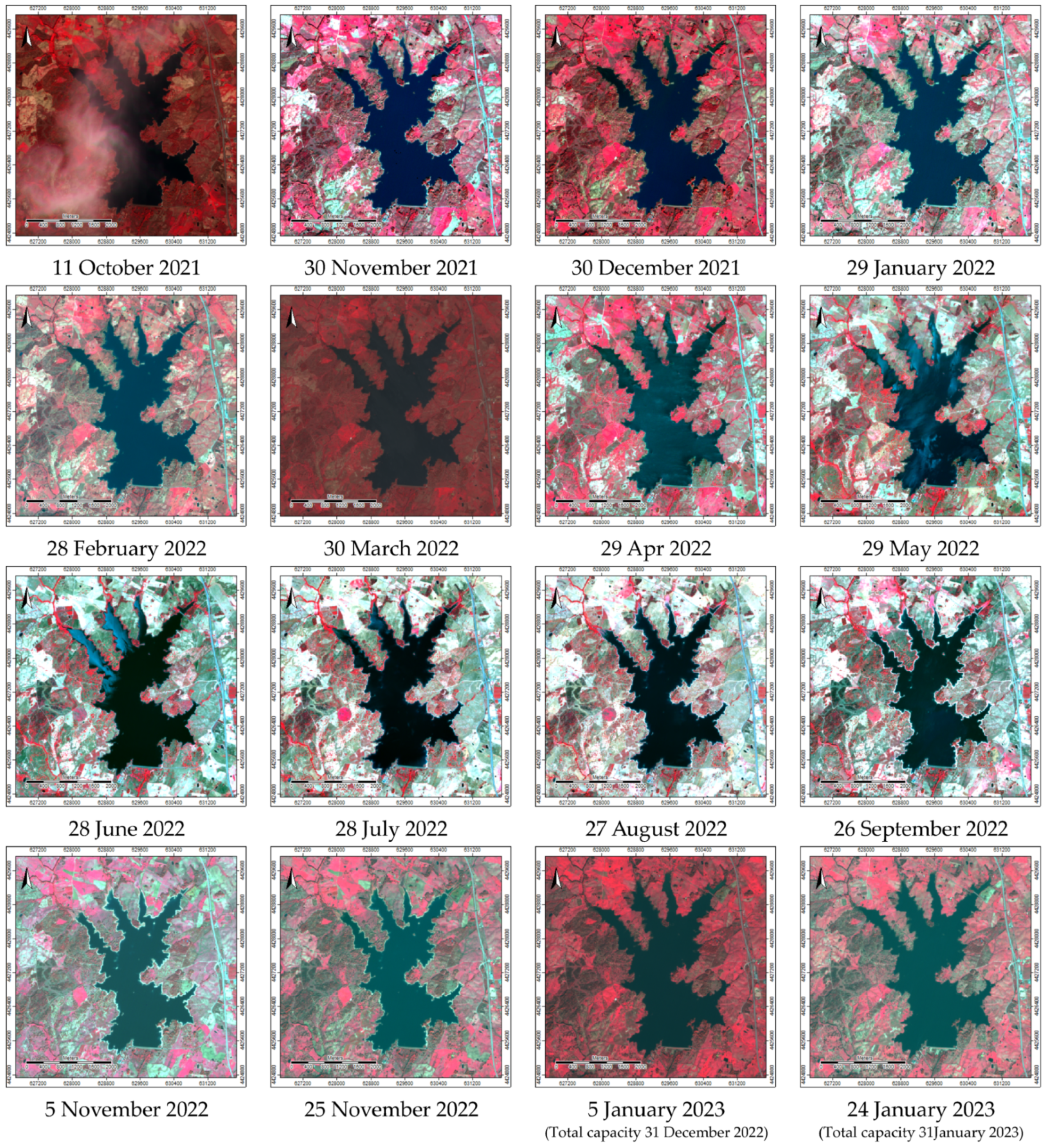
References
- Makanda, K.; Nzama, S.; Kanyerere, T. Assessing the role of water resources protection practice for sustainable water resources management: A Review. Water 2022, 14, 3153. [Google Scholar] [CrossRef]
- Russo, T.; Alfredo, K.; Fisher, J. Sustainable water management in urban, agricultural, and natural systems. Water 2014, 6, 3934–3956. [Google Scholar] [CrossRef]
- Zaghloul, A.; Saber, M.; Gadow, S.; Awad, F. Biological indicators for pollution detection in terrestrial and aquatic ecosystems. Bull. Natl. Res. Cent. 2020, 44, 127. [Google Scholar] [CrossRef]
- Saad Abdelkarim, M. Biomonitoring and bioassessment of running water quality in developing countries: A case study from Egypt. Egypt. J. Aquat. Res. 2020, 46, 313–324. [Google Scholar] [CrossRef]
- El-Serehy, H.A.; Abdallah, H.S.; Al-Misned, F.A.; Irshad, R.; Al-Farraj, S.A.; Almalki, E.S. Aquatic ecosystem health and trophic status classification of the Bitter Lakes along the main connecting link between the Red Sea and the Mediterranean. Saudi J. Biol. Sci. 2018, 25, 204–212. [Google Scholar] [CrossRef]
- Zaghloul, A.; Saber, M.; Abd-El-Hady, M. Physical indicators for pollution detection in terrestrial and aquatic ecosystems. Bull. Natl. Res. Cent. 2019, 43, 120. [Google Scholar] [CrossRef]
- Zaghloul, A.; Saber, M.; El-Dewany, C. Chemical indicators for pollution detection in terrestrial and aquatic ecosystems. Bull. Natl. Res. Cent. 2019, 43, 156. [Google Scholar] [CrossRef]
- Gholizadeh, M.H.; Melesse, A.M.; Reddi, L. A comprehensive review on water quality parameters estimation using remote sensing techniques. Sensors 2016, 16, 1298. [Google Scholar] [CrossRef]
- Cabezas-alzate, D.F.; Garcés, Y.A.; Henao-cespedes, V. LANDSAT-7 ETM+ based remote sensing as a tool for assessing lakes water quality characteristics. J. Southwest Jiaotong Univ. 2021, 56, 291–301. [Google Scholar] [CrossRef]
- Warren, M.A.; Simis, S.G.H.; Selmes, N. Complementary water quality observations from high and medium resolution Sentinel sensors by aligning chlorophyll-a and turbidity algorithms. Remote Sens. Environ. 2021, 265, 112651. [Google Scholar] [CrossRef]
- Chu, H.J.; He, Y.C.; Chusnah, W.N.; Jaelani, L.M.; Chang, C.H. Multi-reservoir water quality mapping from remote sensing using spatial regression. Sustainability 2021, 13, 6416. [Google Scholar] [CrossRef]
- Li, X.; Ding, J.; Ilyas, N. Machine learning method for quick identification of water quality index (WQI) based on Sentinel-2 MSI data: Ebinur Lake case study. Water Sci. Technol. Water Supply 2021, 21, 1291–1312. [Google Scholar] [CrossRef]
- Yang, H.; Kong, J.; Hu, H.; Du, Y.; Gao, M.; Chen, F. A review of remote sensing for water quality retrieval: Progress and challenges. Remote Sens. 2022, 14, 1770. [Google Scholar] [CrossRef]
- Shafique, A.; Cao, G.; Khan, Z.; Asad, M.; Aslam, M. Deep learning-based change detection in remote sensing images: A review. Remote Sens. 2022, 14, 871. [Google Scholar] [CrossRef]
- Gwon, Y.; Kim, D.; You, H.; Nam, S.H.; Kim, Y. A standardized procedure to build a spectral library for hazardous chemicals mixed in river flow using hyperspectral image. Remote Sens. 2023, 15, 477. [Google Scholar] [CrossRef]
- Bria, A.; Cerro, G.; Ferdinandi, M.; Marrocco, C.; Molinara, M. An IoT-ready solution for automated recognition of water contaminants. Pattern Recognit. Lett. 2020, 135, 188–195. [Google Scholar] [CrossRef]
- Miranda, P.M.A.; Coelho, F.E.S.; Tomé, A.R.; Valente, M.A.; Carvalho, A.; Pires, C.; Pires, H.O.; Pires, V.C.; Ramalho, C. 20th Century Portuguese Climate and Climate Scenarios. In Climate Change in Portugal: Scenarios, Impacts and Adaptation Measures (SIAM Project); Santos, F.D., Forbes, K., Moita, R., Eds.; Gradiva: Lisbon, Portugal, 2002; pp. 23–38. [Google Scholar]
- APA. Barragem da Marateca. Comissão Nacional Portuguesa das Grandes Barragens. Agência Portuguesa do Ambiente. Available online: https://cnpgb.apambiente.pt/gr_barragens/gbportugal/FICHAS/Maratecaficha.htm (accessed on 22 March 2023).
- DGT. Especificações Técnicas da Carta de Uso E Ocupação do Solo de Portugal Continental Para 1995, 2007, 2010 E 2015; Relatório técnico; Direção-Geral do Território: Lisboa, Portugal, 2018; Available online: http://www.dgterritorio.pt/cartografia_e_geodesia/cartografia/cartografia_tematica/cartografia_de_uso_e_ocupacao_do_solo__cos_clc_e_copernicus_/ (accessed on 29 March 2023).
- DGT. Carta de Uso E Ocupação do Solo. Registo Nacional de Dados Geográficos. SNIG. Direção-Geral do Território: Lisboa, Portugal. Available online: https://snig.dgterritorio.gov.pt/rndg/srv/por/catalog.search#/search?resultType=details&sortBy=referenceDateOrd&anysnig=COS&fast=index&from=1&to=20 (accessed on 29 March 2023).
- IPMA. Boletins Climatológicos de Portugal Continental. Instituto Português do Mar E da Atmosfera. Available online: https://www.ipma.pt/pt/publicacoes/boletins.jsp?cmbDep=cli&cmbTema=pcl&idDep=cli&idTema=pcl&curAno=-1 (accessed on 29 March 2023).
- Navarro, G.; Caballero, I.; Silva, G.; Parra, P.-C.; Vázquez, Á.; Caldeira, R. Evaluation of forest fire on Madeira Island using Sentinel-2A MSI imagery. Int. J. Appl. Earth Obs. Geoinf. 2017, 58, 97–106. [Google Scholar] [CrossRef]
- Llorens, R.; Sobrino, J.A.; Fernández, C.; Fernández-Alonso, J.M.; Vega, J.A. A methodology to estimate forest fires burned areas and burn severity degrees using Sentinel-2 data. Application to the October 2017 fires in the Iberian Peninsula. Int. J. Appl. Earth Obs. Geoinf. 2021, 95, 102243. [Google Scholar] [CrossRef]
- Gulácsi, A.; Kovács, F. Drought Monitoring with Spectral Indices Calculated From Modis Satellite Images In Hungary. J. Environ. Geogr. 2015, 8, 11–20. [Google Scholar] [CrossRef]
- EOS NDVI FAQ. All You Need To Know About Index. Available online: https://eos.com/blog/ndvi-faq-all-you-need-to-know-about-ndvi/ (accessed on 13 September 2022).
- Lamparelli, M. Graus de Trofia em Corpos D’Agua do Estado de Sao Paulo: Avaliacao dos Métodos de Monitoramento. Ph.D. Thesis, Universidade de São Paulo, São Paulo, Brazil, 2004. [Google Scholar] [CrossRef]
- Ha, N.; Dzung, D.; Hang, H.; Huy, T.; Tu, N. Water quality assessment and eutrophic classification of Hanoi lakes using different indices. Vietnam J. Agric. Sci. 2021, 4, 1229–1240. [Google Scholar] [CrossRef]
- Nojavan, A.F.; Kreakie, B.J.; Hollister, J.W.; Qian, S.S. Rethinking the lake trophic state index. PeerJ 2019, 7, e7936. [Google Scholar] [CrossRef] [PubMed]
- Xu, F.-L.; Jiao, Y. Trophic Classification for Lakes. In Encyclopedia of Ecology, 2nd ed.; Elsevier: Oxford, UK, 2019; pp. 487–494. ISBN 978-0-444-64130-4. [Google Scholar]
- Dodds, W.K.; Jones, J.R.; Welch, E.B. Suggested classification of stream trophic state: Distributions of temperate stream types by chlorophyll, total nitrogen, and phosphorus. Water Res. 1998, 32, 1455–1462. [Google Scholar] [CrossRef]
- Klippel, G.; Macêdo, R.L.; Branco, C.W.C. Comparison of different trophic state indices applied to tropical reservoirs. Lakes Reserv. Sci. Policy Manag. Sustain. Use 2020, 25, 214–229. [Google Scholar] [CrossRef]
- Carlson, R.E. A trophic state index for lakes1. Limnol. Oceanogr. 1977, 22, 361–369. [Google Scholar] [CrossRef]
- Lillesand, T.; Kiefer, R. Remote Sensing and Image Interpretation; John Wiley & Sons: Hoboken, NJ, USA, 1994; 376p. [Google Scholar]
- Spyrakos, E.; O’Donnell, R.; Hunter, P.D.; Miller, C.; Scott, M.; Simis, S.G.H.; Neil, C.; Barbosa, C.C.F.; Binding, C.E.; Bradt, S.; et al. Optical types of inland and coastal waters. Limnol. Oceanogr. 2018, 63, 846–870. [Google Scholar] [CrossRef]
- Cohen, J. A coefficient of agreement for nominal scales. Educ. Psychol. Meas. 1960, 20, 37–46. [Google Scholar] [CrossRef]
- DR. Decreto-Lei n°152/2017 de 7 de Dezembro. Diário da República, I Série-no 235/2017 de 7 de Dezembro. Available online: https://dre.pt/dre/detalhe/decreto-lei/152-2017-114315242 (accessed on 29 March 2023).
- Liu, J.; Zhang, Y.; Yuan, D.; Song, X. Empirical estimation of total nitrogen and total phosphorus concentration of urban water bodies in china using high resolution IKONOS multispectral imagery. Water 2015, 7, 6551–6573. [Google Scholar] [CrossRef]
- Guildford, S.J.; Hecky, R.E. Total nitrogen, total phosphorus, and nutrient limitation in lakes and oceans: Is there a common relationship? Limnol. Oceanogr. 2000, 45, 1213–1223. [Google Scholar] [CrossRef]
- Yan, R.; Gao, J. Key factors affecting discharge, soil erosion, nitrogen and phosphorus exports from agricultural polder. Ecol. Modell. 2021, 452, 109586. [Google Scholar] [CrossRef]
- Bulgakov, N.G.; Levich, A.P. The nitrogen: Phosphorus ratio as a factor regulating phytoplankton community structure. Arch. Für Hydrobiol. 1999, 146, 3–22. [Google Scholar] [CrossRef]
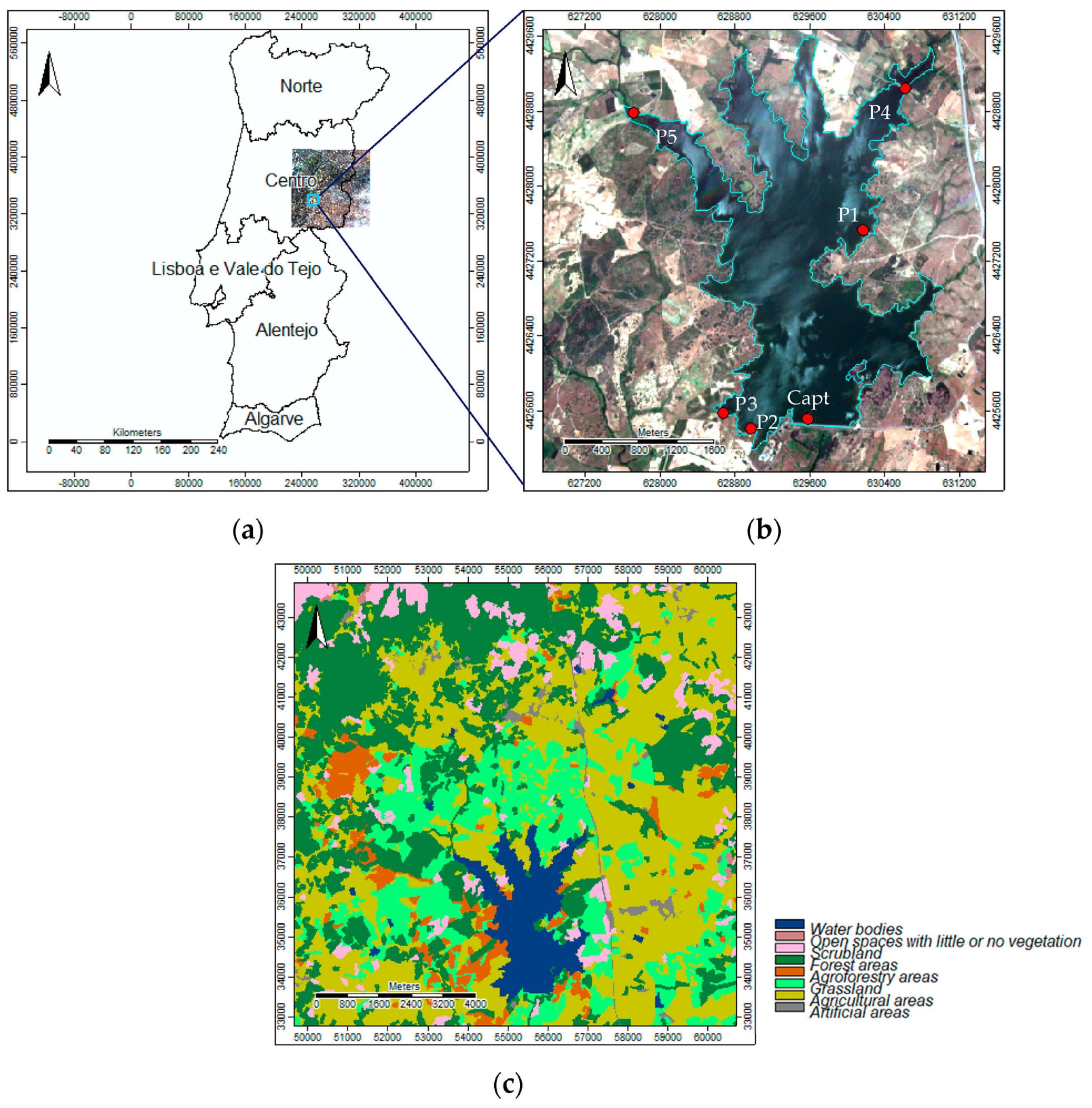


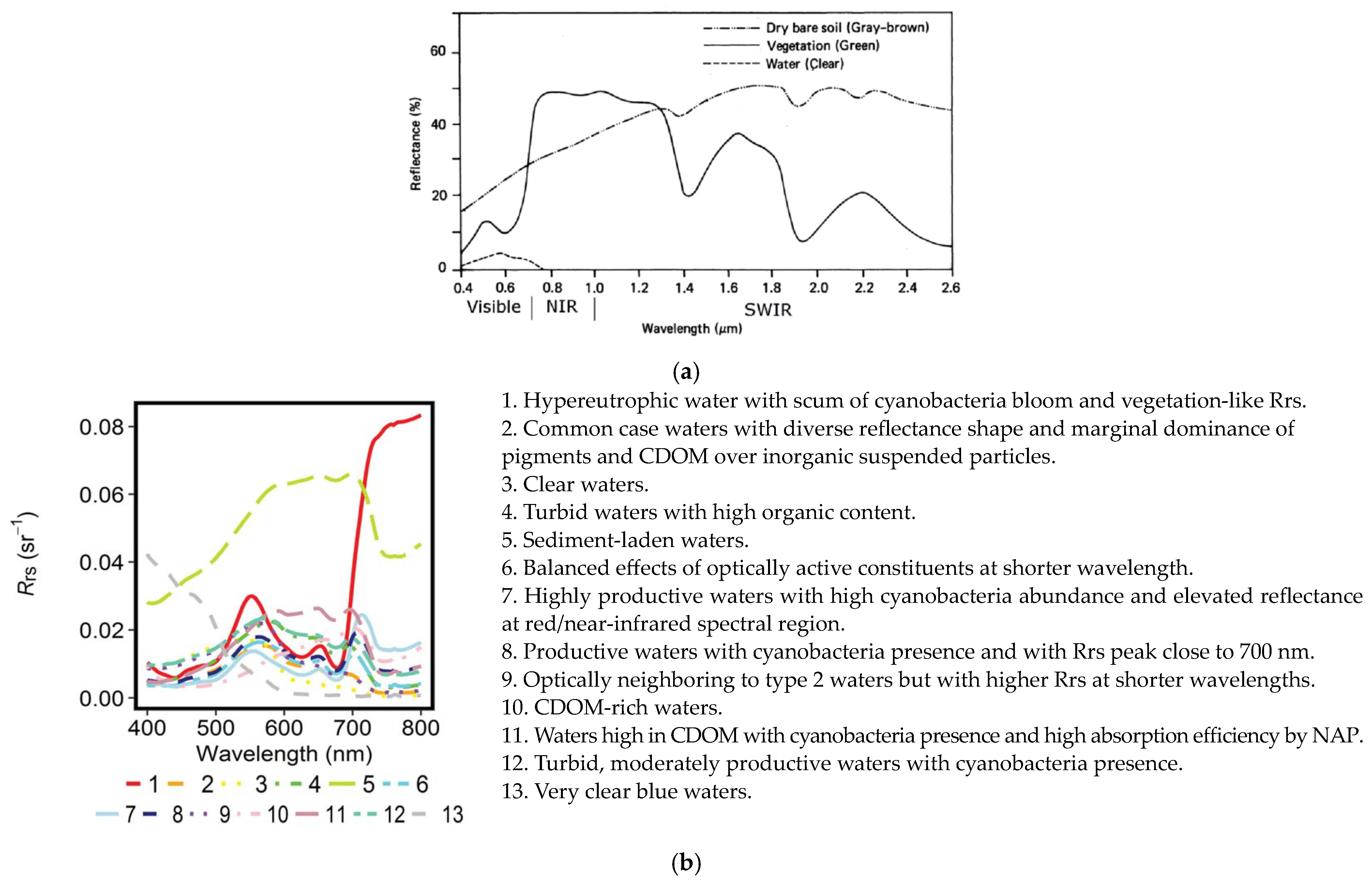
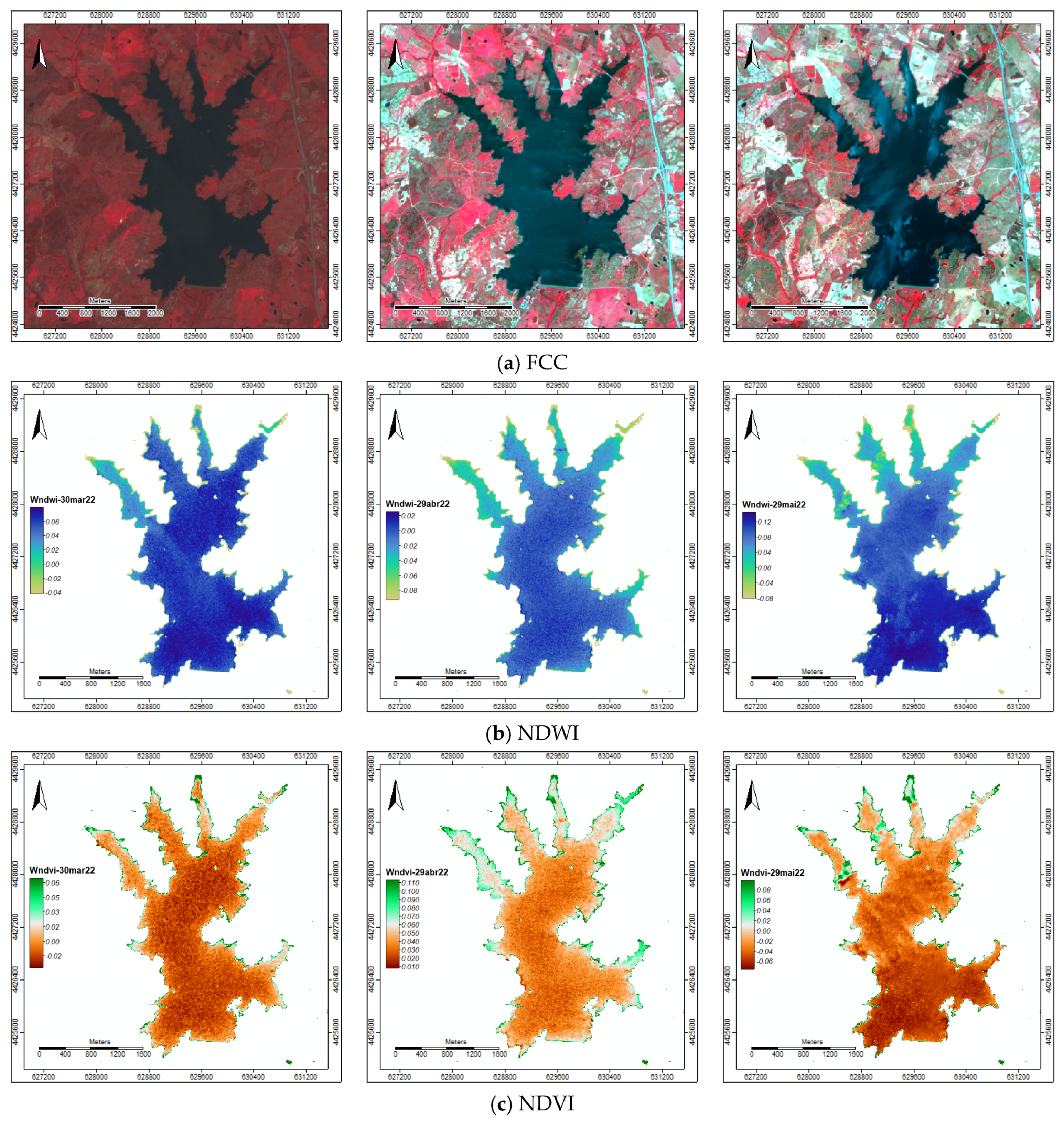

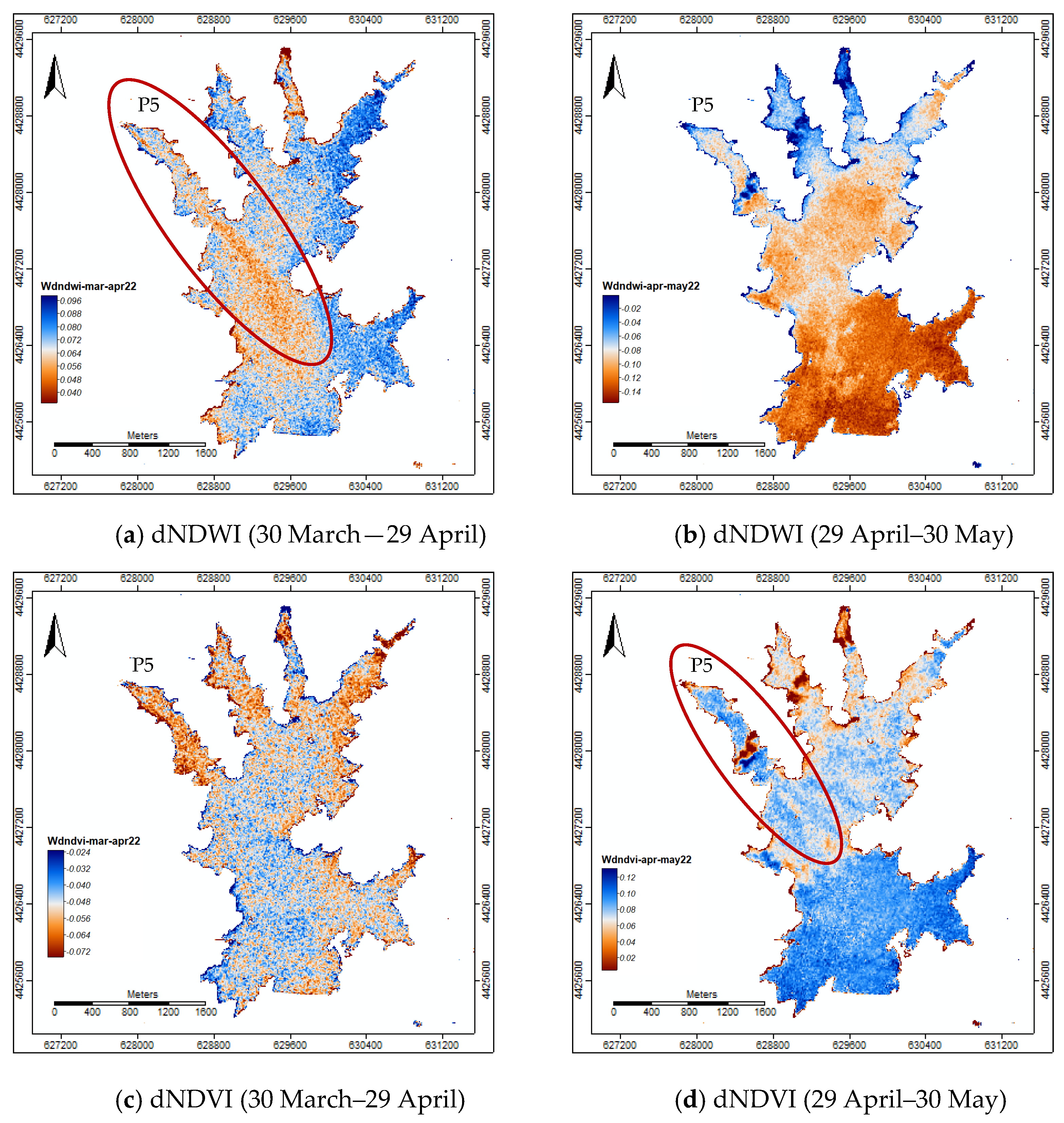
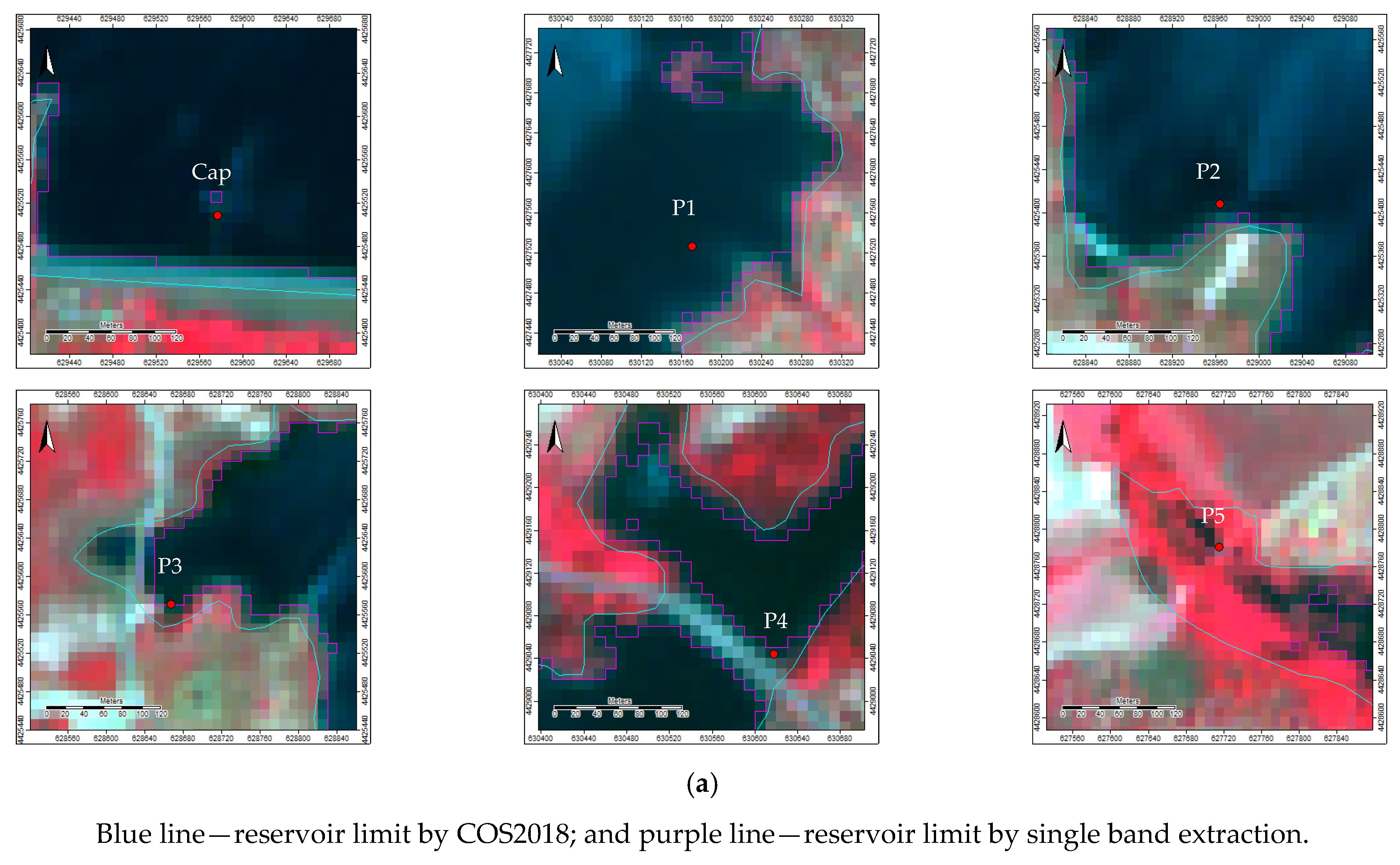
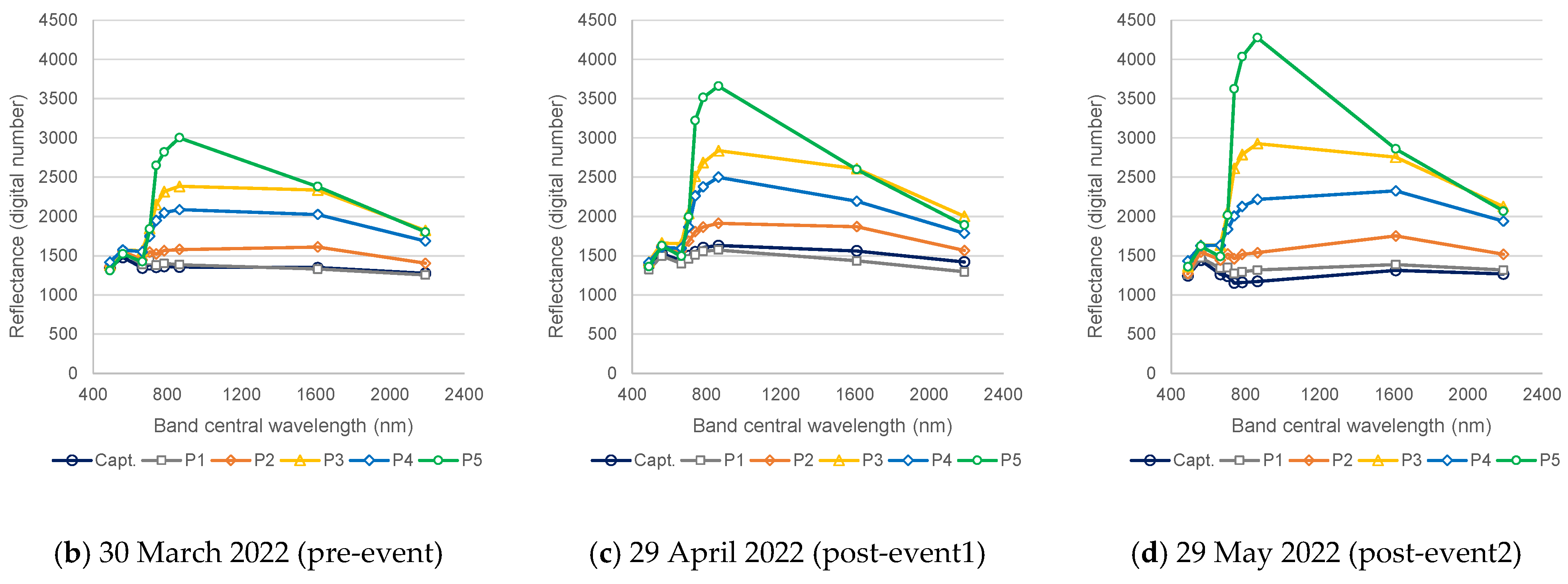
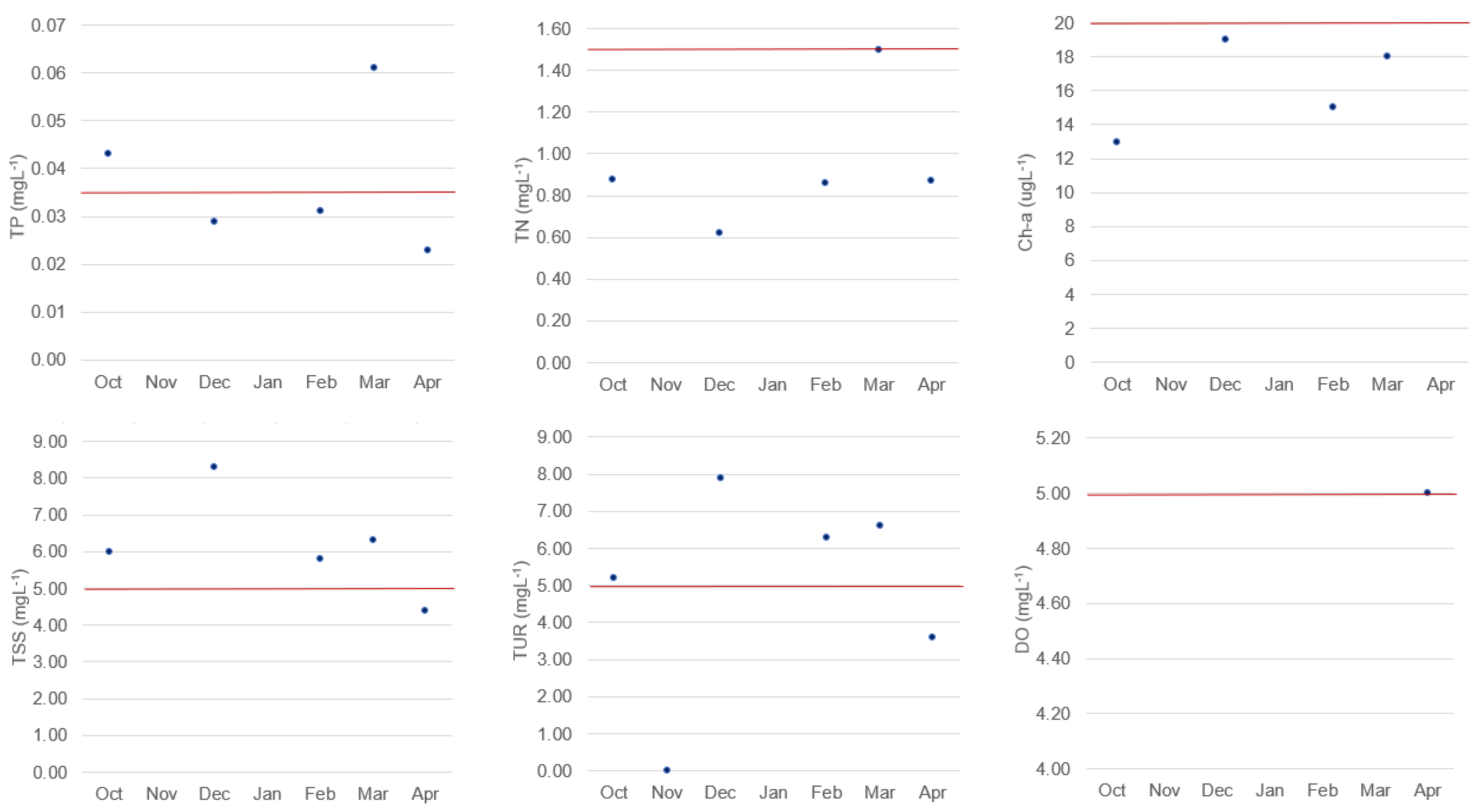
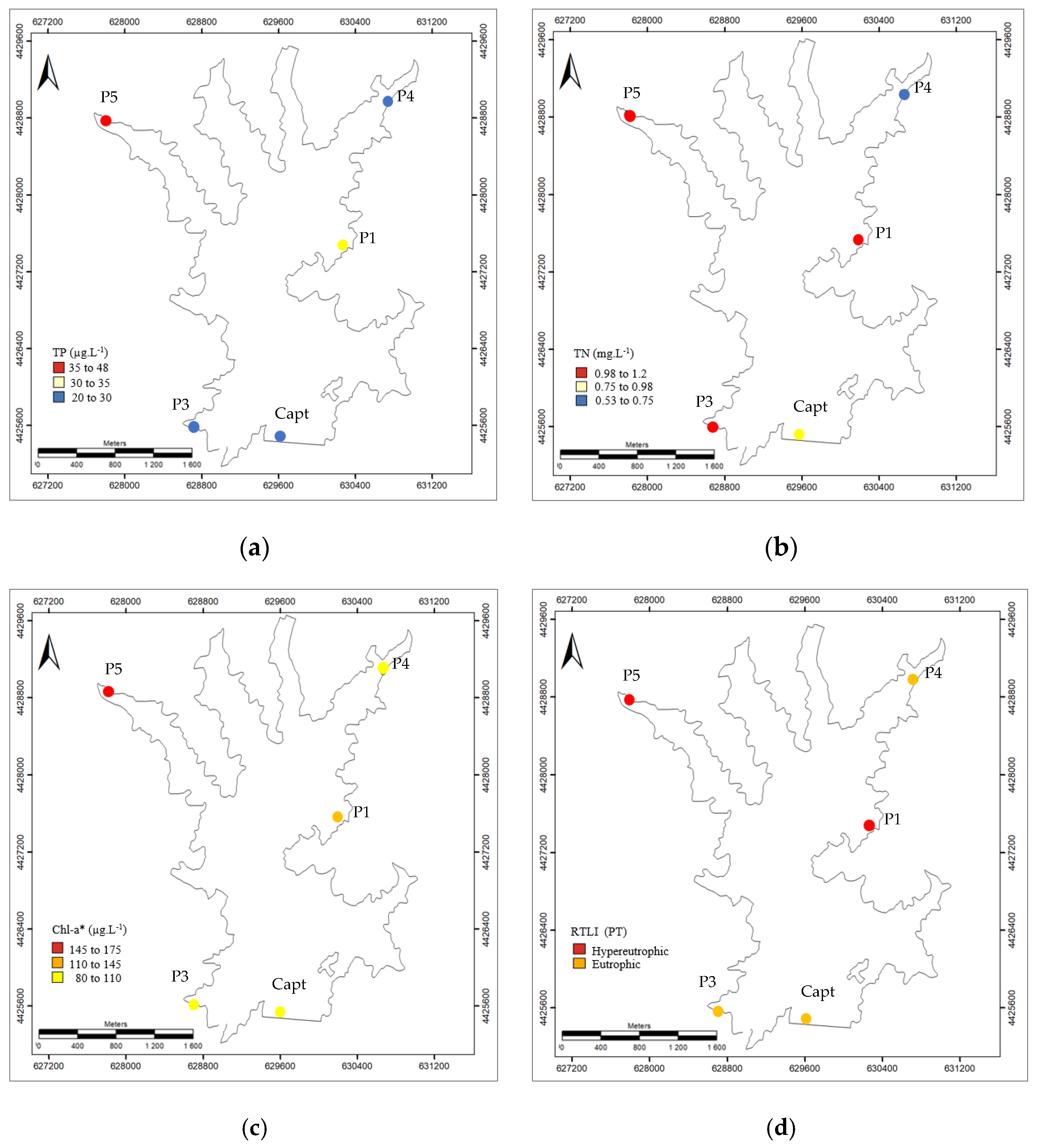
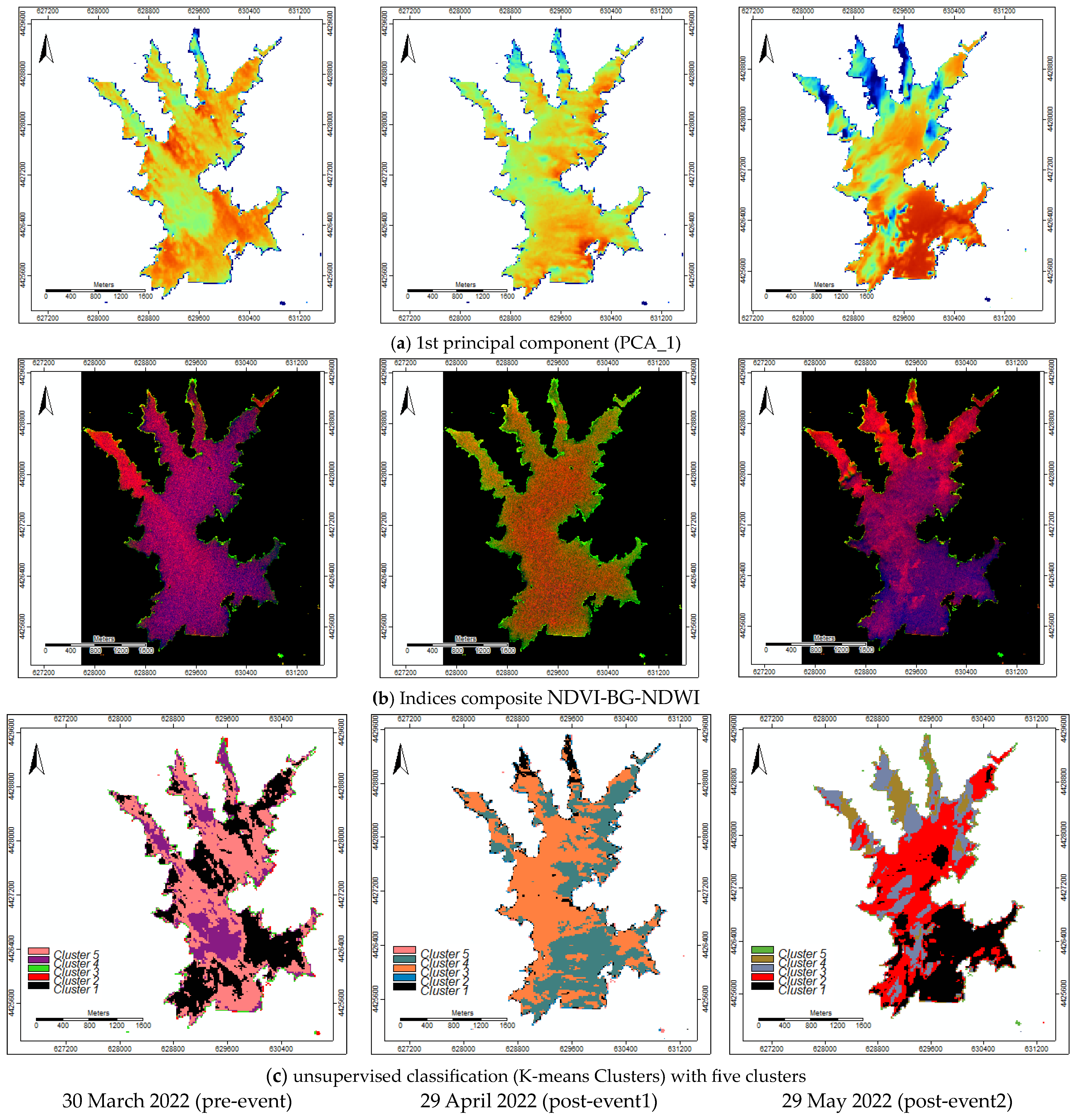
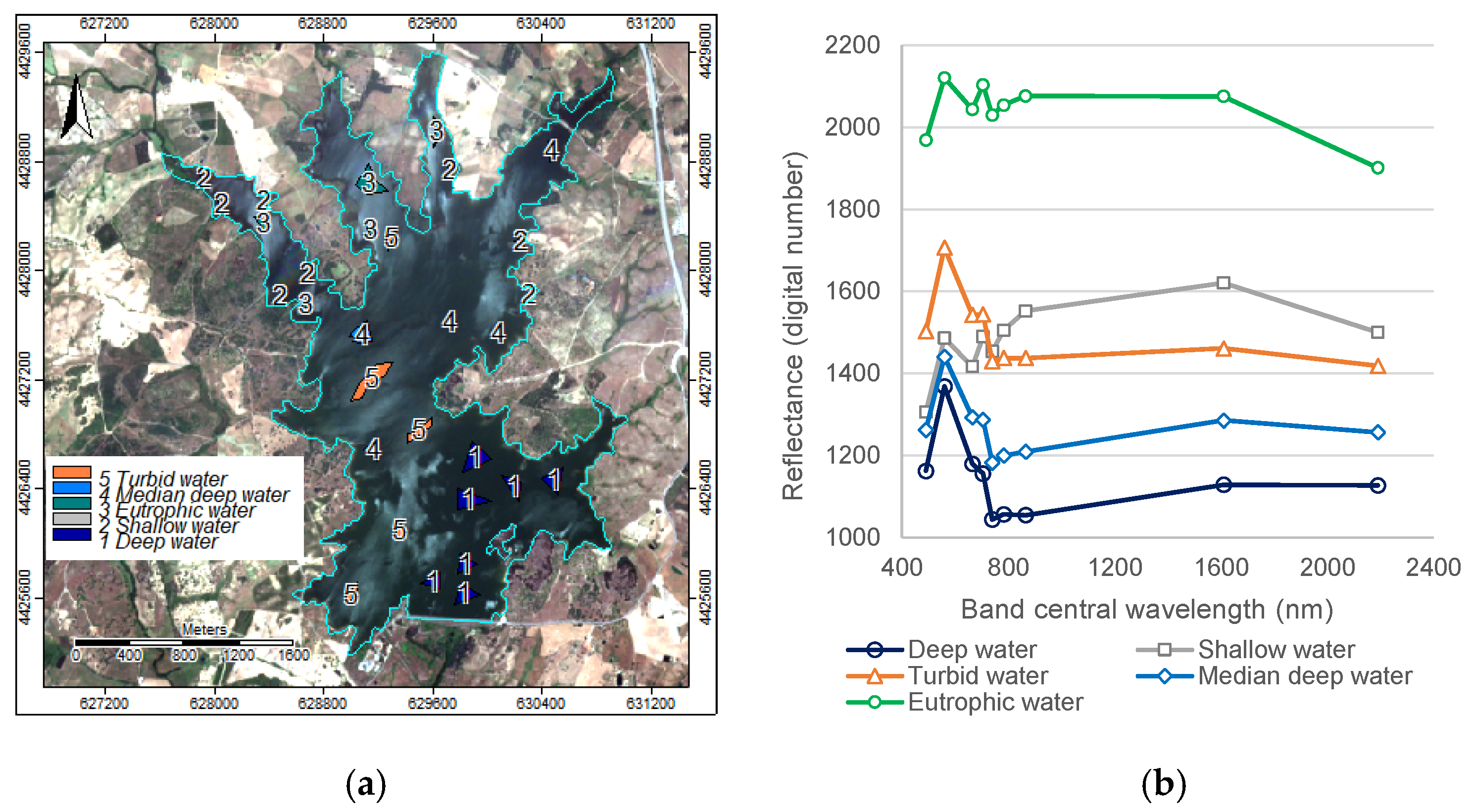
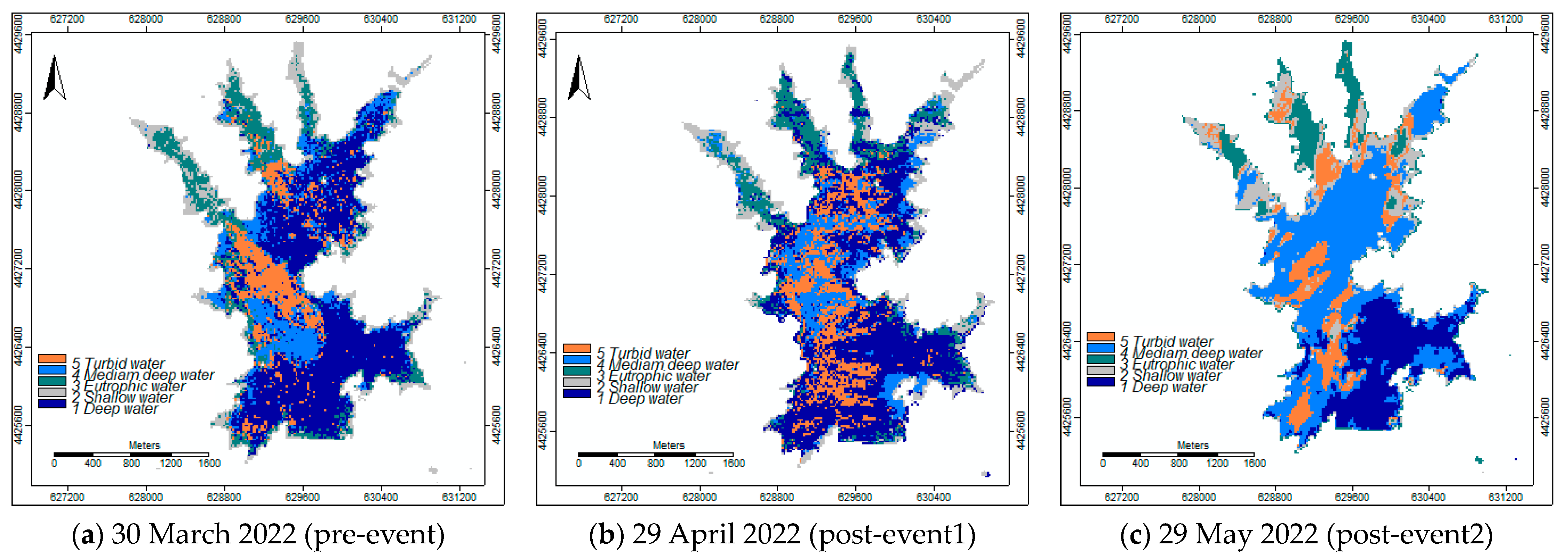
| Band | Name | Central Wavelength (nm) | Spatial Resolution (m) |
|---|---|---|---|
| 1 | Coastal aerosol | 443 | 60 |
| 2 | Blue | 490 | 10 and 20 |
| 3 | Green | 560 | 10 and 20 |
| 4 | Red | 665 | 10 and 20 |
| 5 | Red-edge 1 | 705 | 20 |
| 6 | Red-edge 2 | 740 | 20 |
| 7 | Red-edge 3 | 783 | 20 |
| 8 | NIR | 842 | 10 |
| 8a | NIR narrow | 865 | 20 |
| 9 | Water vapour | 945 | 60 |
| 10 | Cirrus | 1375 | 60 |
| 11 | SWIR 1 | 1610 | 20 |
| 12 | SWIR 2 | 2190 | 20 |
| Year | Date of Acquisition | |||||||||||
|---|---|---|---|---|---|---|---|---|---|---|---|---|
| Jan | Feb | Mar | Apr | May | Jun | Jul | Aug | Sep | Oct | Nov | Dec | |
| 2021 | 11 | 30 | 30 | |||||||||
| 2022 | 29 | 28 | 30 | 29 | 29 | 28 | 28 | 27 | 26 | 5 and 25 | ||
| 2023 | 4 and 24 | |||||||||||
| Acronym | Spectral Bands | Formula | Equation |
|---|---|---|---|
| NDWI | G—green band NIR—near infrared band | ||
| NDVI | R—red band NIR—near infrared band | ||
| B/G | B—blue band G—green band |
Disclaimer/Publisher’s Note: The statements, opinions and data contained in all publications are solely those of the individual author(s) and contributor(s) and not of MDPI and/or the editor(s). MDPI and/or the editor(s) disclaim responsibility for any injury to people or property resulting from any ideas, methods, instructions or products referred to in the content. |
© 2023 by the authors. Licensee MDPI, Basel, Switzerland. This article is an open access article distributed under the terms and conditions of the Creative Commons Attribution (CC BY) license (https://creativecommons.org/licenses/by/4.0/).
Share and Cite
Alegria, C.; Albuquerque, T. Remote Sensing for Water Quality Monitoring—A Case Study for the Marateca Reservoir, Portugal. Geosciences 2023, 13, 259. https://doi.org/10.3390/geosciences13090259
Alegria C, Albuquerque T. Remote Sensing for Water Quality Monitoring—A Case Study for the Marateca Reservoir, Portugal. Geosciences. 2023; 13(9):259. https://doi.org/10.3390/geosciences13090259
Chicago/Turabian StyleAlegria, Cristina, and Teresa Albuquerque. 2023. "Remote Sensing for Water Quality Monitoring—A Case Study for the Marateca Reservoir, Portugal" Geosciences 13, no. 9: 259. https://doi.org/10.3390/geosciences13090259
APA StyleAlegria, C., & Albuquerque, T. (2023). Remote Sensing for Water Quality Monitoring—A Case Study for the Marateca Reservoir, Portugal. Geosciences, 13(9), 259. https://doi.org/10.3390/geosciences13090259







